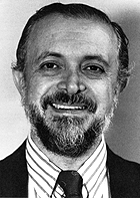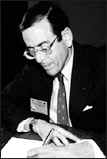|
Experts Discuss |
Opportunities for harmonizing implementation of the ozone and climate change conventions took centre stage when experts gathered at the Massachusetts Institute of Technology campus in Cambridge, Mass, November 2 and 3. Organized by United Nations University (UNU), the United Nations Environment Programme (UNEP), MIT's Global Accords Program, and the Alliance for Global Sustainability (AGS), the meeting focused on the linkages between global accords, the Ozone and Climate Change Conventions in particular. Other topics discussed included convention implementation at the national level, the roles played by financial mechanisms that support implementation and the "Issue Management Approach" highlighted in UN Secretary-General Kofi Annan's Programme for Reform as a coordination tool for UN agencies faced with issues that require an integrated and systematic approach. The meeting also considered opportunities to contribute to the upcoming 10-year review of the Earth Summit (Rio+10) particularly regarding the further implementation of Agenda 21.
Participants included Amb. Richard Benedick, former US chief negotiator for the Ozone Convention and author of Ozone Diplomacy; MIT Professor Mario Molina, a Nobel Prize winner for his work on stratospheric ozone depletion; Amb. Rasmus Rasmusson of Sweden, a visiting scholar at Harvard University; Mr. K. Sarma, former Executive Secretary, Ozone Convention secretariat; Mr. She Shuo Lang, Ozone Multilateral Fund Secretariat; Prof. Edith Brown Weiss, Georgetown University; and Dr. Raman Letchumanan, ASEAN Secretariat. A key issue debated during the meeting is the scientific and policy linkages between the ozone and climate change conventions, specifically substitutes to Ozone Depleting Substances (ODS) within the Ozone Convention which were later found to be potent greenhouse gases. The meeting concluded that the academic community and the UN need to develop a model for promoting synergies in convention implementation. UNU's Inter-linkage initiative started in 1999 with an international conference on synergies and coordination between multilateral environmental agreements. That led to a three-year initiative, now underway, which will culminate in Rio+10. For more information: Inter-linkages
web portal.
|

